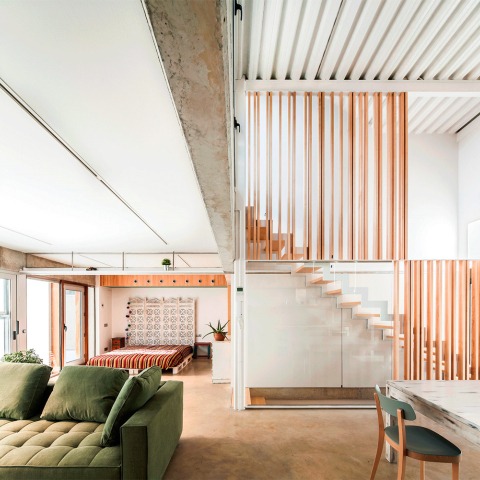For the design of the Migdia House, SAU Taller d'Arquitectura has had two premises set by the future owners which will condition the project's decisions: a house well illuminated and with possible changes in the future.
These premises will be the starting point of the general order of the house, which will centralize their core services and focus around the walls, allowing the passage of light through the façades, and creating a large open central space which ,in the future, may hold different modifications.
- The work to customize the interior spaces of the house is the responsibility of the owner, since the materials are basically treated, sometimes defective execution, where the structure is concrete, glass or polycarbonate and others.

Description of the project by SAU Taller d'Arquitectura
The project starts from two client's requirements:
- A house with plenty of natural light.
- A house with the possibility of increasing in size through the years.
To comply with those requirements SAU Taller de Arquitectura proposes a clear action: to bring services and storage areas to the blank walls leaving a central core which articulates the space around it. With this decision we get the street and courtyard façades free of program. Those façades are facing north and south so they can become a light and ventilation filters. Another consequence of this decision is getting a free and flexible section which will aloud future light slabs to be built if the inhabitants need them. With this aim, concealed anchorages where left into the concrete to aloud simple timber structure to be built in the future.
A multifunctional garage space is located at ground floor level, related to both, street and courtyard, is a space to have familiar meals or courtyard related activities. Facing south at first floor level we find the dinner area, next to it, and facing north we find the kitchen. The bedroom is linked to the living area through a double sliding door that gives different levels of privacy. At roof level and thanks to the section flexibility we find two terraces, the first one, protected with a vegetal pergola is more private, the second is an open one and works as a solarium. The two side concrete walls are not perpendicular to the main façade, so in order to organize the plan the remaining spaces are used as a service and storage areas.
Integrated with the core we find the bathroom, and slightly moved to the north-east corner we have the stairs, this layout defines spaces with different proportions around the program which improves the relation between them. A small internal patio is located in the core to illuminate the central areas and the bathroom, in the future can contain the lift.
The two main façades had been thought as a triple skin. They act as a filter to improve internal light, temperature and comfort conditions. The outer skin is made of 4cm cellular polycarbonate and the inner one is made of double glass, movable aluminium louvres are located between those two layers. Facing south, we have the possibility to open or close the chamber between the polycarbonate and the glass depending on ventilation requirements: during winter time this chamber will remain closed and louvres will be orientated towards the interior to get more radiation, during summer time the chamber will remain opened and louvres will face exterior, that way we stop direct radiation exposure. If needed, is also possible to totally open the inner glass layer to ventilate the whole space from south to north. The house is been designed to get the best comfort using passive techniques. We only use 3 climate mechanical elements: one ventilated hearth, a fan system, and a thermostat with ducts that brings the worm air accumulated in the higher areas of the double height down to the lower levels and a heat pump as an additional support.
We have worked with neutral and rough materials: concrete, glass, polycarbonate, maple timber... trying to create a non contaminated space which allows the inhabitants to bring their own colour and personality with the chosen furniture, vegetation, paints, lamps, racks... in a way we are trying to project a daily life support.
Text.- SAU Taller d'Arquitectura.
CREDITS. DATA SHEET.-
Architects.- SAU Taller d'Arquitectura.
Collaborators.- Claudia Galicia (building engineer), Josep Arisa (envelopes).
Location.- Granollers, Barcelona, Spain.
Built surface.- 172,80 sqm.
Promoter.- Familia Iñigo Soley.
Construction.- Art i Construcció SL.
PEM.- 110.000€.






































